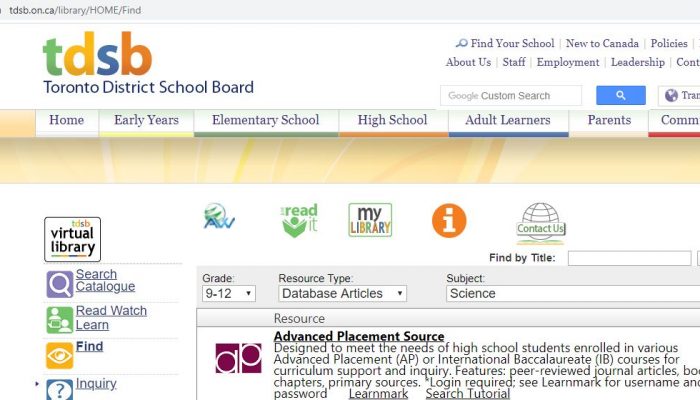Monday May 4th, 2020
Welcome to the Library, Ms. Magon’s HSP3U Class!
Ms. Magson’s Grade 11 Introduction to Anthropology, Psychology, and Sociology class will be coming to the Virtual Library to research their Mental Illness Case File assignment and review how to create a Bibliography using Chicago Style Citation.
For this assignment, you’ll need quality resources from different areas.
Resources for the HSP3U
If we were at school, we would be showing you our fairly extensive collection of books on many of your topics. In lieu of this, Ms Magson has shared with you the Toronto Public Library’s Overdrive Access information so that you are able to obtain information from their e-book collection.
To access media resources, use our Catalogue; found on the Virtual Library. The Catalogue provides you access to streaming video and other digital resources. You’ll need to log in with your TDSB information to access the Catalogue as well as use the digital learnmark for passwords to Learn360 and CBC Curio. (see note in red below)
To access a reliable database such as Advanced Placement Source, you’ll need to go through the Virtual Library, click on the yellow FIND button, choose Grades 9-12 and it will be the first entry you see. It is Password Protected. The login and passwords for EBSCO databases like AP Source and Global Issues in Context are listed on the digital learnmark accessible on the home page of the Virtual Library in the top right corner.
The Centre for Addiction and Mental Health (CAMH) is also a great resource accessed through the Virtual Library as well. It is not password protected.
Other online sites can be useful too and we have added some links here to a few that we think may be helpful.
A valuable resource is the Vanier Institute of the Family, which has excellent research on mental health and its impact upon families. Use the Search feature to find information on your illness/disorder.
The Government of Canada website may be helpful.
Using the search box in Healthlink B.C.’s website , may help you find information about your topic as a starting point.
Quebec’s government webpage for mental health may also yield some initial results.
There are websites and organizations specific to some illnesses such as Tourette’s Syndrome so that may be an option to look into as you are researching.
Citation
You will be using the 17th updated version of the Chicago Manual of Style.
The new file can be found here at Chicago Citation at Laurier.
The basics are unchanged, but we feel that this new resource will provide you with a thorough overview of the expectations laid out by the 17th Edition of the Chicago Manual of Style. Remember to use Ms. Magson’s example Bibliography as posted in your classroom for details specific to your class.
Citing Videos
You’ll find all manners of differing opinions on how to cite videos. To be honest, it can be daunting. If you’re citing a video that you found online, it’s probably best to go straight to the Chicago Manual of Style.
Section 14.280 of the Manual list the elements of an online video citation:
- If known, the name of the principle subject of the recording, such as a presenter, interviewee, journalist, or director..
- The title of the video clip, placed in “quotation marks.”
- The medium of the recording or name of the website on which the recording is located — YouTube video, MPEG file, New York Times video, etc. The manual is not clear on when to list the medium of the recording vs. the name of the website.
- The time length of the recording
- The date on which the recording was uploaded
- The URL at which the recording may be found
As always, we direct you to using OWLPurdue for more examples or to answer citation questions.





